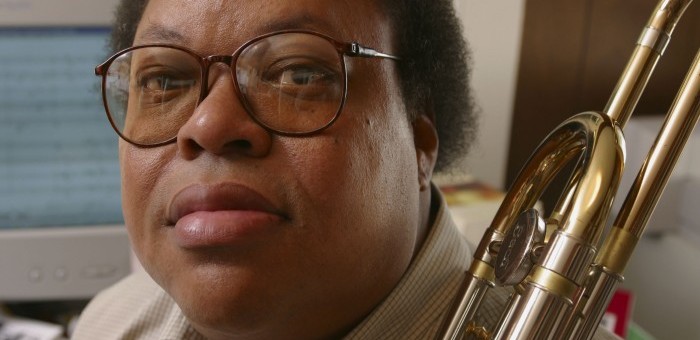Apr 2, 2024 12:59 PM
Saxophonist, Sonic Explorer Casey Benjamin Dies at 45
Casey Benjamin, the alto saxophonist, vocalist, keyboardist and producer who stamped his distinctive sounds on the…

George Lewis is featured on the album The Kitchen Improvisers 1976–1983.
(Photo: Courtesy of MacArthur Foundation)George Lewis’ concert at The Kitchen in Manhattan on Feb. 9 put the spotlight on an archival album that’s not entirely his. The Kitchen Improvises 1976–1983 (Orange Mountain Music) features a long and wonderful solo trombone track by Lewis alongside vintage recordings of performances by other revered artists, including percussionist Gerry Hemingway, multi-instrumentalist Earl Howard, saxophonist Oliver Lake and reedist Roscoe Mitchell.
But Lewis compiled the collection and, in a sense, compiled himself and eight other artists into an evening of improvisation styled after the late British guitarist Derek Bailey’s revered Company nights. The role wasn’t unfamiliar to Lewis, who was The Kitchen’s music director from 1980–’82, but on this night he kept his emcee duties to a minimum. “I used to do this here at the Kitchen,” he told the audience with characteristic humility. “I think I’ve forgotten how to do it.”
The evening opened with sound artist Andrea Parkins and composer-improviser Lucie Vítková, both of whom had their accordions on hand. There’s a beautiful fragility to Vítková’s recordings, and her improvised passages demonstrated a similar delicateness, with quick notes passing by almost like happenstance. Parkins used her accordion primarily for surface sounds to be looped and processed.
Keyboardist/saxophonist Howard, clarinetist Michael Lytle and vocalist and patron Thomas Buckner made for a fluid trio with Howard setting up and taking down sonic scrims while Buckner and Lytle engaged in rapid dialogue.
The conversation grew more engaged in a duet by Lake and composer-performer Miya Masaoka, which proved to be the most interwoven improvisation of the evening. Masaoka bowed the strings of her amplified koto (a traditional Japanese stringed instrument) as Lake switched between alto and curved soprano saxophones, his playing fitting into the crevices and pushing its way back out as she laid into the thick strings.
Lewis first took the stage as a player with sound artist (and former DNA drummer) Ikue Mori, the two benefitting from the most shared experience of the duos. Mori’s sound choices are unmistakable, inextricably linked to her musical training as a percussionist. Lewis circled her with tonality, occasional recorded voices and some surprisingly deep bass, keeping one eye toward her, always responding, circling and responding again.
The cast thusly introduced, Lewis called larger groups for the second half. First came himself (on trombone now) with Lake, Vítková and Howard, the latter again behind and below the ensuing thicket. Buckner, Lytle, Masaoka, Mori and Parkins then played the most abstract and volatile piece of the evening, with Masaoka using a metal bowl as a sustain-inhibiting slide.
Addressing the audience again, Lewis stepped momentarily into professorial mode. “Somehow over the last 40 years this idea has developed, you have small groups and then you put everyone up there to play,” he said. “I used to do this a lot with Derek Bailey. Somebody would say, ‘Let’s all play together,’ and he’d say, ‘That never works.’ But we’d try it anyway and he was right: It didn’t work.”
The comment drew laughs and, perhaps, broke a jinx. The nonet proved to be the strongest part of the night. Every performer felt subdued and respectful of the process, with Buckner, Masaoka or Lake only occasionally rising to the surface. The group eventually made its way toward a slow pulse without entirely conforming to it.
The program couldn’t, of course, represent 40 years of improvisation in about 90 minutes, but it did represent three generations, three nationalities, two genders and a variety of ethnicities. It also represented a breadth of music that has long fallen beyond classification. And in that sense it represented The Kitchen well, not to mention the city itself.

Benjamin possessed a fluid, round sound on the alto saxophone, and he was often most recognizable by the layers of electronic effects that he put onto the instrument.
Apr 2, 2024 12:59 PM
Casey Benjamin, the alto saxophonist, vocalist, keyboardist and producer who stamped his distinctive sounds on the…

“He’s constructing intelligent musical sentences that connect seamlessly, which is the most important part of linear playing,” Charles McPherson said of alto saxophonist Sonny Red.
Feb 27, 2024 1:40 PM
“I might not have felt this way 30 to 40 years ago, but I’ve reached a point where I can hear value in what people…

Albert “Tootie” Heath (1935–2024) followed in the tradition of drummer Kenny Clarke, his idol.
Apr 5, 2024 10:28 AM
Albert “Tootie” Heath, a drummer of impeccable taste and time who was the youngest of three jazz-legend brothers…

“Both of us are quite grounded in the craft, the tradition and the harmonic sense,” Rosenwinkel said of his experience playing with Allen. “Yet I felt we shared something mystical as well.”
Mar 12, 2024 11:42 AM
“There are a few musicians you hear where, as somebody once said, the molecules in the room change. Geri was one of…

Larry Goldings’ versatility keeps him in high demand as a leader, collaborator and sideman.
Feb 21, 2024 10:45 AM
Are you having any fun? Larry Goldings certainly is. Consider just two recent examples:
Scene 1: “If anyone had…